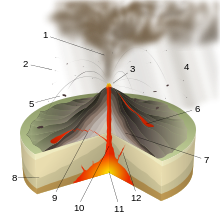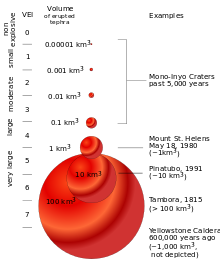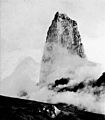There are three different metatypes of eruptions. The most well-observed are magmatic eruptions, which involve the decompression of gas within magma that propels it forward. Phreatomagmatic eruptions are another type of volcanic eruption, driven by a the compression of gas within magma, the direct opposite of the process powering magmatic activity. The last eruptive metatype is the Phreatic eruption, which is driven by the superheating of steam via contact with magma; these eruptive types often exhibit no magmatic release, instead causing the granulation of existing rock.
Within these wide-defining eruptive types are several subtypes. The weakest are Hawaiian and submarine, then Strombolian, followed by Vulcanian and Surtseyan. The stronger eruptive types are Pelean eruptions, followed by Plinian eruptions; the strongest eruptions are called "Ultra Plinian." Subglacial and Phreatic eruptions are defined by their eruptive mechanism, and vary in strength. An important measure of erruptive strength is Volcanic Explosivity Index (VEI), a magnitudic scale ranging from 0 to 8 that often correlates to eruptive types.

Mosaic of some eruptive structures formed during volcanic activity: An eruption column from a Plinian eruption, Pahoehoe lava flow from a Hawaiian eruption, and a lava arc from a Strombolian eruption.
* Eruption mechanisms
Volcanic eruptions arise through three main mechanisms:
- Gas release under decompression causing magmatic eruptions.
- Thermal contraction from chilling on contact with water causing phreatomagmatic eruptions.
- Ejection of entrained particles during steam eruptions causing phreatic eruptions.[1]
There are two types of eruptions in terms of activity, explosive eruptions and effusive eruptions. Explosive eruptions are characterized by gas-driven explosions that propels magma and tephra.[1] Effusive eruptions, meanwhile, are characterized by the outpouring of lava without significant explosive eruption.[2]
Volcanic eruptions vary widely in strength. On the one extreme there are effusive Hawaiian eruptions, which are characterized by lava fountains and fluid lava flows, which are typically not very dangerous. On the other extreme, Plinian eruptions are large, violent, and highly dangerous explosive events. Volcanoes are not bound to one eruptive style, and frequently display many different types, both passive and explosive, even the span of a single eruptive cycle.[3] Volcanoes do not always erupt vertically from a single crater near their peak, either. Some volcanoes exhibit lateral and fissure eruptions. Notably, many Hawaiian eruptions start from rift zones,[4] and some of the strongest Surtseyan eruptions develop along fracture zones.[5]
* Volcano explosivity index
The Volcanic Explosivity Index (commonly shortened VEI) is a scale, from 0 to 8, for measuring the strength of eruptions. It is used by the Smithsonian Institution's Global Volcanism Program in assessing the impact of historic and prehistoric lava flows. It operates in a way similar to the Richter scale for earthquakes, in that each interval in value represents a tenfold increasing in magnitude (it is logarithmic).[6] The vast majority of volcanic eruptions are of VEIs between 0 and 2.[3]| VEI | Plume height | Eruptive volume * | Eruption type | Frequency ** | Example |
|---|---|---|---|---|---|
| 0 | <100 m (330 ft) | 1,000 m3 (35,300 cu ft) | Hawaiian | Continuous | Kilauea |
| 1 | 100–1,000 m (300–3,300 ft) | 10,000 m3 (353,000 cu ft) | Hawaiian/Strombolian | Months | Stromboli |
| 2 | 1–5 km (1–3 mi) | 1,000,000 m3 (35,300,000 cu ft) † | Strombolian/Vulcanian | Months | Galeras (1992) |
| 3 | 3–15 km (2–9 mi) | 10,000,000 m3 (353,000,000 cu ft) | Vulcanian | Yearly | Nevado del Ruiz (1985) |
| 4 | 10–25 km (6–16 mi) | 100,000,000 m3 (3.53×109 cu ft) | Vulcanian/Peléan | Few years | Galunggung (1982) |
| 5 | >25 km (16 mi) | 1 km3 (0.24 cu mi) | Plinian | 5–10 years | Mount St. Helens (1980) |
| 6 | >25 km (16 mi) | 10 km3 (2 cu mi) | Plinian/Ultra Plinian | 1,000 years | Krakatoa (1883) |
| 7 | >25 km (16 mi) | 100 km3 (20 cu mi) | Ultra Plinian | 10,000 years | Tambora (1815) |
| 8 | >25 km (16 mi) | 1,000 km3 (200 cu mi) | Ultra Plinian | 100,000 years | Lake Toba (74 ka) |
| * This is the minimum eruptive volume necessary for the eruption to be considered within the category. ** Values are a rough estimate. Exceptions occur. † There is a discontinuity between the 2nd and 3rd VEI level; instead of increasing by a magnitude of 10, the value increases by a magnitude of 100 (from 10,000 to 1,000,000). | |||||
* Magmatic eruptions
Magmatic eruptions produce juvenile clasts during explosive decompression from gas release. They range in intensity from the relatively small lava fountains on Hawaii to catastrophic Ultra Plinian eruption columns more than 30 km (19 mi) high, bigger than the AD 79 eruption that buried Pompeii.[1][edit] Hawaiian
Main article: Hawaiian eruption

Diagram of a Hawaiian eruption. (key: 1. Ash plume 2. Lava fountain 3. Crater 4. Lava lake 5. Fumaroles 6. Lava flow 7. Layers of lava and ash 8. Stratum 9. Sill 10. Magma conduit 11. Magma chamber 12. Dike) Click for larger version.
Hawaiian eruptions often begin as a line of vent eruptions along a fissure vent, a so-called "curtain of fire." These die down as the lava beings to concentrate at a few of the vents. Central-vent eruptions, meanwhile, often take the form of large lava fountains (both continuous and sporadic), which can reach heights of hundreds of meters or more. The particles from lava fountains usually cool in the air before hitting the ground, resulting in the accumulation of cindery scoria fragments; however, when the air is especially thick with clasts, they cannot cool off fast enough due to the surrounding heat, and hit the ground still hot, the accumulation of which forms splatter cones. If eruptive rates are high enough, they may even form splatter-fed lava flows. Hawaiian eruptions are often extremely long lived; Pu'u O'o, a cinder cone of Kilauea, has been erupting continuously since 1983. Another Hawaiian volcanic feature is the formation of active lava lakes, self-maintaining pools of raw lava with a thin crust of semi-cooled rock; there are currently only 5 such lakes in the world, and the one at Kīlauea's Kupaianaha vent is one of them.[4]
Flows from Hawaiian eruptions are basaltic, and can be divided into two types by their structural characteristics. Pahoehoe lava is a relatively smooth lava flow that can be billowy or ropey. They can move as one sheet, by the advancement of "toes," or as a snaking lava column. A'a lava flows are denser and more viscous then pahoehoe, but tend to move slower. Flows can measure 2 to 20 m (7 to 66 ft) thick. A'a flows are so thick that the outside layers cools into a rubble-like mass, insulating the still-hot interior and preventing it from cooling. A'a lava moves in a peculiar way—the front of the flow steepens due to pressure from behind until it breaks off, after which the general mass behind it moves forward. Pahoehoe lava can sometimes become A'a lava due to increasing viscosity or increasing rate of shear, but A'a lava never turns into pahoehoe flow.[7]
Hawaiian eruptions are responsible for several unique volcanological objects. Small volcanic particles are carried and formed by the wind, chilling quickly into teardrop-shaped glassy fragments known as Pele's tears (after Pele, the Hawaiian volcano deity). During especially high winds these chunks may even take the form of long drawn out rods, known as Pele's hair. Sometimes basant aerates into reticulite, the lowest density rock type on earth.[4]
Although Hawaiian eruptions are named after the volcanoes of Hawaii, they are not necessarily restricted to them; the largest lava fountain ever recorded formed on the island of Izu Ōshima (on Mount Mihara) in 1986, a 1,600 m (5,249 ft) gusher that was more than twice as high as the mountain itself (which stands at 764 m (2,507 ft)).[4][8]
Volcanoes known to have Hawaiian activity include:
- Pu'u O'o, a parasitic cinder cone located on Kilauea on the island of Hawaiʻi which has been erupting continuously since 1983. The eruptions began with a 6 km (4 mi)-long fissure-based "curtain of fire" on January 3. These gave way to centralized eruptions on the site of Kilauea's east rift, eventually building up the still active cone.[4]
- For a list of all of the volcanoes of Hawaii, see List of volcanoes in the Hawaiian - Emperor seamount chain.
- Mount Etna, Italy.[4]
- Mount Mihara in 1986 (see above paragraph)[4]
*Vulcanian
Main article: Vulcanian eruption

Diagram of a Vulcanian eruption. (key: 1. Ash plume 2. Lapilli 3. Lava fountain 4. Volcanic ash rain 5. Volcanic bomb 6. Lava flow 7. Layers of lava and ash 8. Stratum 9. Sill 10. Magma conduit 11. Magma chamber 12. Dike) Click for larger version.
Initial Vulcanian activity is characterized by a series of short-lived explosions, lasting a few minutes to a few hours and typified by the ejection of volcanic bombs and blocks. These eruptions wear down the lava dome holding the magma down, and it disintegrates, leading to much more quiet and continuous eruptions. Thus an early sign of future Vulcanian activity is lava dome growth, and its collapse generates an outpouring of pyroclastic material down the volcano's slope.[17]
Deposits near the source vent consist of large volcanic blocks and bombs, with so-called "bread-crust bombs" being especially common. These deeply cracked volcanic chunks form when the exterior of ejected lava cools quickly into a glassy or fine-grained shell, but the inside continues to cool and vesiculate. The center of the fragment expands, cracking the exterior. However the bulk of Vulcanian deposits are fine grained ash. The ash is only moderately dispersed, and its abundance indicates a high degree of fragmentation, the result of high gas contents within the magma. In some cases these have been found to be the result of interaction with meteoric water, suggesting that Vulcanian eruptions are partially hydrovolcanic.[17]
Volcanoes that have exhibited Vulcanian activity include:
- Sakurajima, Japan has been the site of Vulcanian activity near-continuously since 1955.[19]
- Tavurvur, Papua New Guinea, one of several volcanoes in the Rabaul Caldera.[17]
- Irazú Volcano in Costa Rica exhibited Vulcanian activity in its 1965 eruption.[20]
*Strombolian
Main article: Strombolian eruption

Diagram of a Strombolian eruption. (key: 1. Ash plume 2. Lapilli 3. Volcanic ash rain 4. Lava fountain 5. Volcanic bomb 6. Lava flow 7. Layers of lava and ash 8. Stratum 9. Dike 10. Magma conduit 11. Magma chamber 12. Sill) Click for larger version.
The term "Strombolian" has been used indiscriminately to describe a wide variety of volcanic eruptions, varying from small volcanic blasts to large eruptive columns. In reality, true Strombolian eruptions are characterized by short-lived and explosive eruptions of lavas with intermediate viscosity, often ejected high into the air. Columns can measure hundreds of meters in height. The lavas formed by Strombolian eruptions are a form of relatively viscous basaltic lava, and its end product is mostly scoria.[9] The relative passivity of Strombolian eruptions, and its non-damaging nature to its source vent allow Strombolian eruptions to continue unabated for thousands of years, and also makes it one of the least dangerous eruptive types.[11]

An example of the lava arcs formed during Strombolian activity. This image is of Stromboli itself.
Strombolian eruptions are similar to Hawaiian eruptions, but there are differences. Strombolian eruptions are noisier, produce no sustained eruptive columns, do not produce some volcanic products associated with Hawaiian volcanism (specifically Pele's tears and Pele's hair), and produce fewer molten lava flows (although the eruptive material does tend to form small rivulets).[9][11]
Volcanoes known to have Strombolian activity include:
- Parícutin, Mexico, which erupted from a fissure in a cornfield in 1943. Two years into its life, pyroclastic activity began to wane, and the outpouring of lava from its base became its primary mode of activity. Eruptions ceased in 1952, and the final height was 424 m (1,391 ft). This was the first time that scientists are able to observe the complete life cycle of a volcano.[9]
- Mount Etna, Italy, which has displayed Strombolian activity in recent eruptions, for example in 1981, 1999,[12] 2002-2003, and 2009.[13]
- Mount Erebus in Antarctica, the southernmost active volcano in the world, having been observed erupting since 1972.[14] Eruptive activity at Erebrus consists of frequent Strombolian activity.[15]
- Stromboli itself. The namesake of the mild explosive activity that it possesses has been active throughout historical time; essentially continuous Strombolian eruptions, occasionally accompanied by lava flows, have been recorded at Stromboli for more than a millennium.[16]
*Peléan
Main article: Peléan eruption

Diagram of Peléan eruption. (key: 1. Ash plume 2. Volcanic ash rain 3. Lava dome 4. Volcanic bomb 5. Pyroclastic flow 6. Layers of lava and ash 7. Stratum 8. Magma conduit 9. Magma chamber 10. Dike) Click for larger version.
Peléan eruptions are characterized most prominently by the incandescent pyroclastic flows that they drive. The mechanics of a Peléan eruption are very similar to that of a Vulcanian eruption, except that in Peléan eruptions the volcano's structure is able to withstand more pressure, hence the eruption occurs as one large explosion rather than several smaller ones.[24]
Volcanoes known to have Peléan activity include:
- Mount Pelée, Martinique. The 1902 eruption of Mount Pelée completely devastated the island, destroying the town of St. Pierre and leaving only 3 survivors.[25] The eruption was directly preceded by lava dome growth.[17]
- Mayon Volcano, the Philippines most active volcano. It has been the site of many different types of eruptions, Peléan included. Approximarly 40 ravines radiate from the summit and provide pathways for frequent pyroclastic flows and mudslides to the lowlands below. Mayon's most violent eruption occurred in 1814 and was responsible for over 1200 deaths.[26]
- The 1951 Peléan eruption of Mount Lamington. Prior to this eruption the peak had not even been recognized as a volcano. Over 3,000 people were killed, and it has become a benchmark for studying large Peléan eruptions.[27]
| | | Mount Lamington following the devastating 1951 eruption. |
Sumber :
http://en.wikipedia.org/wiki/Types_of_volcanic_eruptions







Tidak ada komentar:
Posting Komentar